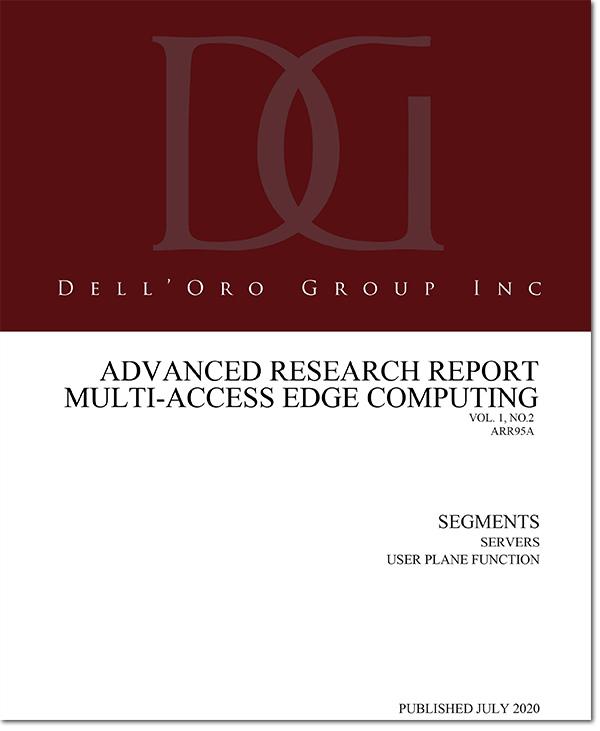Industry Standards Organizations and Service Provider Alliances Work Together to Promote MEC
 We just published the July 2020 Multi-Access Edge Computing (MEC) market forecast report. The industry collaboration and the momentum being achieved, our July 2020 five-year MEC forecast (2019 to 2024) has doubled from our January 2020 forecast. The market is still expected to start slow but greatly accelerates in the second half of the forecast period. We expect the China market will be leading in the scale of MEC deployments and will represent the largest regional market. Here are some key takeaways from the report:
We just published the July 2020 Multi-Access Edge Computing (MEC) market forecast report. The industry collaboration and the momentum being achieved, our July 2020 five-year MEC forecast (2019 to 2024) has doubled from our January 2020 forecast. The market is still expected to start slow but greatly accelerates in the second half of the forecast period. We expect the China market will be leading in the scale of MEC deployments and will represent the largest regional market. Here are some key takeaways from the report:
- Dell’Oro Group’s MEC report covers what is known as the Infrastructure Edge, on the upstream side of an access network. It does not cover the Device Edge, on the user side of the access network. Content Delivery Networks (CDNs) and virtual Radio Access Networks (vRAN) are also not included.
- 5G Service Providers are expected to be the primary connectivity providers for MEC Systems per the market defined. Cloud Service Providers will partner with 5G Service Providers to extend their services to 5G systems.
- Since the publication of the January 2020 MEC report, 3GPP and European Telecommunication Standards Institute (ETSI) have continued to update the MEC specifications.
- ETSI published a new white paper in July 2020, “Harmonizing standards for edge computing – A synergized architecture leveraging ETSI ISG MEC and 3GPP specifications.” This white paper has outlined the collaboration between ETSI and 3GPP to prevent any fragmentation in the MEC ecosystem.
- 3GPP has already drafted a specification incorporating the harmonization.
- GSMA has been rallying the Service Providers into working together under the umbrella of the Operator Platform for Edge Cloud Computing, a concept outlined in a January 2020 white paper.
- In Phase 1, the Operator Platform Concept is focusing on federated multiple operator’s edge computing infrastructure to give application providers access to a global edge cloud to run innovative, distributed, and low latency services through a set of common application programmable interfaces (APIs).
- Service Providers have created alliances to work on these issues such as the Bridge Alliance Global MEC Task Force and the 5G Future Forum.
- In July 2020, fruits of these efforts were publicized between Deutsche Telekom and Telefónica who implemented a cross-border trial with the MobiledgeX’s aggregated platform that validates federated Telco Edge Cloud for differentiated XR gaming.
- 5G Automotive Association (5GAA) has partnered with ETSI now on two Plugtests. The 5GAA supports the idea that 5G will be the ultimate platform to enable Cooperative Intelligent Transportation Systems (C-ITS) and the provision of V2X (vehicle-to-everything) communications.
Click here to learn more about Dell’Oro Multi-Access Edge Computing Advanced Research Report. If you want to get a sample of the report, please contact us.
Dell’Oro Group’s Advanced Research Report on Multi-Access Edge Computing offers an overview of the MEC market, including a five-year forecast. The report’s sections include: Definition and Scope, Market Drivers, Use Cases, System Architecture, Vendor Ecosystem, the U.S. MEC System Deployment Model, and MEC Revenue and Shipment Forecast for Servers and the Packet Core User Plane Function. The market is segmented by Public MEC and Private MEC, and offers a worldwide view of the total available market in units. To purchase this report, please contact us at dgsales@delloro.com.
 Dell’Oro Group published an update to its research on Network Equipment (NE) Services. The following are some of the key takeaways from the report.
Dell’Oro Group published an update to its research on Network Equipment (NE) Services. The following are some of the key takeaways from the report. Balancing Broadband Subscriber Growth with Supply Chain Constraints
Balancing Broadband Subscriber Growth with Supply Chain Constraints